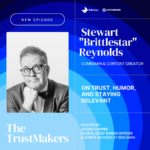By Eric Shiffman, VP of Product Marketing, Yieldmo
For decades, media selection was understood as a natural extension of audience targeting. Advertisers didn’t just focus on who they wanted to reach—they considered where their message would appear. Premium publishers, whether iconic magazines or trusted news outlets, provided more than just access to an audience; they offered credibility and contextual alignment that enhanced the impact of the ad itself. The environment wasn’t just a delivery mechanism for the message—it was part of the message, shaping how it was received and perceived.
This balance began to shift with the rise of digital advertising. The internet didn’t create audience targeting, but it transformed it into a highly precise, real-time practice. Programmatic advertising enabled brands to chase audiences across an ever-expanding ecosystem, often prioritizing efficiency over quality. This singular focus on audience has disrupted the historical equation, treating all media placements as interchangeable vehicles for reach rather than differentiated environments.
The Commodification of Media
The fixation on audiences, detached from context, has forced premium publishers to compete for ad budgets on the same level as low-quality sites. Decades—or even centuries—of reputation-building have been undermined by the assumption that reaching the “right person” is all that matters, regardless of where they are reached.
This commodification has led to a system where high-quality, trusted environments are devalued. Low-quality, made-for-advertising (MFA) sites thrive, offering nothing more than access to a targeted audience. Advertisers, once willing to pay a premium for the prestige and contextual resonance of outlets like Vogue or The New York Times, now see little difference between these environments and those that exist purely to serve ads. As a result, premium publishers are losing ground—not because their content is less effective, but because the system fails to recognize its value.
The consequences extend beyond publishers. For brands, this commodification has increased risks. Ads that appear in subpar environments can dilute brand equity, eroding trust and damaging credibility. Consumers notice where brands show up, and when that context feels incongruent or inappropriate, it undermines the very targeting strategies advertisers are trying to perfect.
Structural Challenges in Programmatic Advertising
This shift isn’t just about perception; it’s deeply embedded in how advertising is planned and executed. Budgeting, workflows, and team structures within agencies and brands have siloed audience targeting and contextual targeting as separate strategies. Different tools, technologies, and teams reinforce this divide, further diminishing the role of context in advertising strategies.
The result? Ads may reach the right people but fail to resonate because they appear in environments that undermine the message. Conversely, ads placed in premium environments may miss their audience entirely due to a lack of precision. This inefficiency reflects the broader consequences of separating audience and context.
For example, a luxury automotive brand targeting high-net-worth individuals might successfully identify its audience through behavioral data but run ads on low-quality sites designed purely to generate clicks. Even if the audience is accurate, the environment undercuts the brand’s premium image, creating dissonance rather than engagement.
Reuniting Audience and Context
Rebuilding the connection between audience and context isn’t just a nostalgic return to the past—it’s a strategic imperative. Privacy regulations and the deprecation of signals like cookies and mobile IDs are forcing advertisers to rethink their reliance on audience data alone. Contextual targeting, once sidelined, is reemerging as a critical strategy.
By integrating audience insights with contextual signals, advertisers can craft campaigns that are both precise and resonant. For example, technology now allows for real-time adjustments that consider both who the user is and the environment they’re engaging with, reducing reliance on third-party data and ensuring relevance. A campaign for a health-conscious snack brand, for instance, can dynamically pair audience segments with health and fitness content, delivering ads that feel not only relevant but also appropriate to the setting.
This unified approach benefits all stakeholders. Advertisers achieve better performance by aligning message and medium, publishers regain their rightful position as trusted partners, and consumers encounter advertising that feels less intrusive and more aligned with their interests.
A Path to Relevance and Impact
The commodification of media placements has reached a breaking point. To move forward, advertisers must dismantle the artificial divide between audience and context. The future lies in unified strategies that respect the value of both—the precision of audience targeting and the credibility of premium environments.
This isn’t just a correction; it’s an opportunity. By recognizing the full value of where ads appear, alongside whom they reach, brands can create campaigns that are not only effective but enduring. Premium publishers, once relegated to competing on the same terms as low-value sites, can reclaim their rightful place as essential partners in delivering relevance, resonance, and results.
The reintegration of audience and context marks the beginning of a new era—one where advertisers, publishers, and consumers alike can benefit from campaigns that don’t just target but truly connect.











